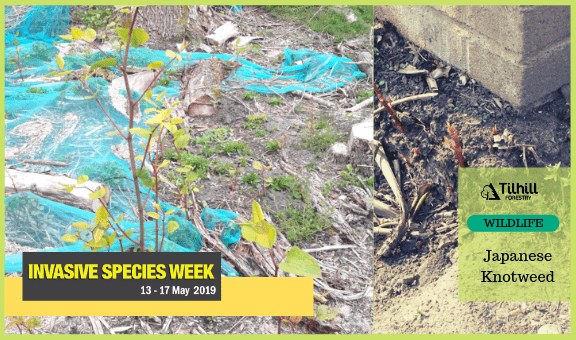Japanese Knotweed
This week Tilhill Forestry will be sharing their Toolbox Talks on Invasive Species for Invasive Species Week including the Do’s and Dont’s when dealing with them.
What?
Japanese Knotweed was introduced to the UK as an ornamental plant but has spread extensively in the wild. With its rapid growth of more that 20mm a day, it forms dense clumps over 3m high which crowd out and prevent the growth of native plants.
The rhizome root system, from which new plants grow, can extend several metres away from the original plant and be up to 2m deep. The plantspreads so rapidly not only through progression of its root system but because any fragments of its stem or root will grow to form a new plant (a piece as small as 0.8 grams can regenerate). This makes it a very difficult plant to eradicate.
Japanese Knotweed will grow in any type of soil no matter how poor and is often found along railways, riverbanks, roads and particularly on derelict sites.
Identification
Japanese Knotweed forms dense clumps and grows up to 3 metres tall. The stem is hollow with distinct nodes like bamboo and breaks easily. In Spring it is fleshy and red tinged and in Summer it is green with purple speckles.
Leaves in Spring are pinky red and uncurl as the stem grows. In Summer they become large oval or heart shaped mid-green.
Flowers are cream coloured and appear in drooping clusters towards the end of August.
The plant dies before November often leaving behind the upright brown, hollow, woody stalks.
Why?
• Avoid environmental harm: Japanese Knotweed shades out native plants by producing a dense canopy of leaves early in the growing season. Although Japanese Knotweed is not toxic to humans or animals, it offers a poor habitat for insects, birds and mammals.
• Avoid prosecution: It is illegal “to plant or otherwise encourage” the growth of Japanese Knotweed. This could include cutting the plant or roots and disturbing or moving surrounding soil which may contain root material unless as part of an eradication process.
DO ✅
✅ Immediately STOP all work within 7 metres of the suspect plant and contact your line manager for instructions if you think you have identified Japanese Knotweed on your site.
DON’T ❌
❌ Excavate or move any soil from within 7 metres of a Japanese Knotweed plant without instruction.
❌ Track plant or vehicles over the area.
❌ Stockpile potentially contaminated material within 10 metres of a watercourse or drain.



